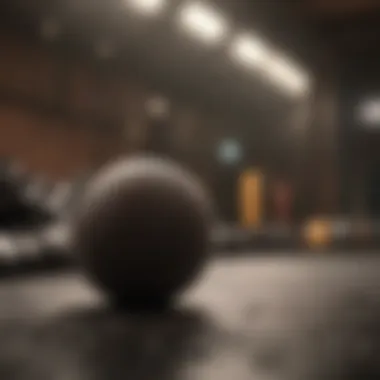Effective Exercises to Alleviate Sciatica Pain


Intro
Sciatica, characterized by pain radiating along the sciatic nerve, often causes discomfort that can significantly hinder daily activities. Understanding sciatica involves recognizing that the pain stems from compression or irritation of the nerve, frequently due to herniated discs, spinal stenosis, or other underlying spinal issues. This article aims to offer insights into effective exercises that can alleviate sciatica pain, improve mobility, and foster overall well-being.
Adopting a targeted approach to exercise can play a crucial role in recovery. Each exercise is designed to strengthen the muscles supporting the spine, enhance flexibility, and correct posture. Emphasizing the importance of lifestyle modifications will also be addressed. Readers will find practical routines and adjustments that can empower them to manage their symptoms effectively.
Key Takeaways
- Sciatica results from nerve compression or irritation, often causing significant discomfort.
- Targeted exercises can effectively alleviate pain and enhance mobility.
- Lifestyle changes and posture improvements are crucial for long-term relief.
- This guide includes specific exercises and techniques tailored for individuals dealing with sciatica.
Importance of Targeted Exercises
Implementing exercises specifically designed for sciatica can lead to more effective pain relief. These exercises usually focus on strengthening core muscles, stretching hamstrings, and improving overall body mechanics. They can also aid in reducing inflammation around the affected nerve, thus minimizing pain perception.
Additionally, these exercises can lead to improved range of motion, allowing individuals to perform daily tasks with greater ease. Simple adjustments in posture and body mechanics during exercise can also prevent future episodes of sciatica pain, making this an essential component of recovery.
In-Depth Analysis
Scientific research supports the idea that physical activity is critical in managing sciatica. A study conducted by the American Journal of Physical Medicine & Rehabilitation found that individuals who engaged in consistent physical therapy experienced better outcomes than those who avoided movement. This correlation highlights the need for structured exercise programs tailored to the specific needs of those suffering from sciatica.
Moreover, specific stretching routines have been shown to improve nerve function and relieve tension in the lower back. By focusing on flexibility and strength, exercises like the piriformis stretch and pelvic tilts can reinforce proper alignment and reduce nerve compression.
"Regular physical activity not only helps alleviate sciatica pain but also prevents future occurrences by promoting robust musculoskeletal systems."
Focusing on posture during both exercise and daily activities can also mitigate stress on the sciatic nerve. Standing and sitting correctly can make a notable difference in how one experiences sciatica pain. This article will delve further into specific exercises and lifestyle adjustments to support recovery and enhance quality of life.
Understanding Sciatica
Sciatica refers to pain that is caused by irritation or compression of the sciatic nerve. This nerve, the longest in the body, runs from the lower back through the hips and buttocks, and down each leg. In the context of this article, understanding sciatica is essential because it lays a foundation for how specific exercises can impact pain relief. Recognizing the symptoms and causes of sciatica allows individuals to make informed decisions about their health and wellness journey. It highlights the necessity of specific movements, while also encouraging preventive measures.
Definition and Symptoms
Sciatica typically presents as pain that radiates along the path of the sciatic nerve. This discomfort can emerge suddenly or develop gradually. Symptoms may include:
- Pain: This can be sharp, shooting, or a dull ache.
- Numbness or Tingling: Often felt in the leg or foot.
- Weakness: Individuals may find it difficult to move one leg or foot.
Often, the pain is more acute when sitting, coughing, or sneezing. Understanding these symptoms is critical for early intervention and management.
Causes of Sciatica
Several factors may lead to sciatica. The most common causes include:
- Herniated Discs: Discs that bulge or rupture can press on the sciatic nerve.
- Spinal Stenosis: A narrowing of the spinal canal can create nerve compression.
- Piriformis Syndrome: This occurs when the piriformis muscle irritates the sciatic nerve.
- Injuries: Trauma to the lower back or pelvis can result in nerve compression.
Each cause has distinct characteristics and may necessitate different approaches to treatment and exercise routines.
Who Is At Risk?
Understanding who is at risk for sciatica can help in adopting preventive strategies and appropriate exercises. Factors that elevate the risk include:
- Age: People between 30 and 50 years old are more susceptible.
- Sedentary Lifestyle: Lack of activity can weaken muscles that support the spine.
- Obesity: Excess weight can increase stress on the spine.
- Occupation: Jobs that require heavy lifting or prolonged sitting can contribute.
Awareness of these risk factors can provide individuals with insight into lifestyle changes that may alleviate symptoms or prevent future episodes.
The Role of Exercise in Pain Relief
Exercise plays a critical role in the management of sciatica pain. Physical activity helps improve flexibility, strengthens muscles, and promotes overall well-being. Engaging in regular exercise can reduce inflammation and muscle tension around the sciatic nerve. This is important because pain relief often relies on addressing these underlying issues.
Chronic sciatica can stem from various causes, including a herniated disc or spinal stenosis. Implementing exercise, therefore, becomes a strategic approach not just for pain relief but also for prevention. An active lifestyle contributes to better weight management. Excess weight can put additional stress on the spine and contribute to discomfort. Thus, establishing a regular exercise routine is significant for those dealing with sciatica.
Moreover, exercise has psychological benefits. Many individuals experience stress and anxiety linked to chronic pain conditions. Physical activity fosters the release of endorphins, leading to improved mood. This mental aspect ties into a greater commitment to managing sciatica effectively. Patients often find they are more motivated and hopeful when they feel physically engaged.
Why Exercise Matters


Exercise matters greatly for individuals experiencing sciatica. It contributes to a multifaceted approach in managing pain. Improved strength and flexibility can lead to enhanced posture. Good posture reduces strain on the lower back, alleviating some common causes of sciatica. This highlights the functional benefits of exercise—not only does it relieve pain, but it also fosters better overall health.
Additionally, indulging in specific exercises helps in recovery. Techniques such as stretching and controlled movements can relieve nerve compression, which is a primary factor behind sciatica. The simple act of moving can promote blood flow, which speeds up recovery and encourages healing in injured areas.
"Regular physical activity is one of the most effective ways to alleviate the symptoms of sciatica and improve physical function."
Types of Exercises for Sciatica
There are various types of exercises that can effectively alleviate sciatica pain. These can be categorized into stretching exercises, strengthening exercises, and low-impact activities. Each category has unique benefits tailored to target specific symptoms associated with sciatica.
Stretching Exercises:
These focus on improving flexibility. Stretching helps relieve tight muscles that may be pressing on the sciatic nerve. Exercises such as hamstring stretches, piriformis stretches, and the child’s pose can be particularly effective.
Strengthening Exercises:
Targeted strengthening routines can support the spine. Exercises like glute bridges, core stabilization exercises, and wall sits help build the abdominal and back muscles. Stronger core muscles reduce the risk of injury and provide stability to the spine.
Low-Impact Activities:
Engaging in activities like walking, swimming, and cycling promotes cardiovascular health. These activities are less likely to exacerbate pain while still providing beneficial movement. They enhance mobility without putting excessive stress on the body.
In summary, exercise is not just a supplementary measure; it can significantly influence the trajectory of sciatica management. Engaging regularly and mindfully in these exercises can lead to lasting relief and better overall health.
Stretching Exercises
Stretching exercises play a crucial role in alleviating sciatica pain, as they can enhance flexibility and reduce tension in the muscles surrounding the spine. When the muscles are tight, they can compress the sciatic nerve or irritate its pathways, leading to pain and discomfort. By incorporating stretching routines into your daily regimen, you can promote better mobility, relax your muscles, and decrease the likelihood of further injury.
The benefits of stretching exercises extend beyond immediate pain relief. Regular practice can improve your overall posture, support spinal health, and increase blood circulation in affected areas. It is important to note that not all stretches are suitable for everyone, and individuals should listen to their bodies to avoid strain.
Hamstring Stretch
The hamstring stretch is essential for individuals with sciatica pain. Tight hamstrings can increase stress on the lower back, exacerbating discomfort. To perform this stretch, sit on the floor with your legs extended straight in front.
- Bend forward gently, reaching for your toes.
- Hold for 15 to 30 seconds, feeling the stretch in the back of your thigh.
- Repeat two to three times.
Ensure to keep your back straight during the stretch to avoid additional strain.
Piriformis Stretch
The piriformis muscle, located in the buttocks, can sometimes pinch the sciatic nerve if tight. To relieve this pressure, the piriformis stretch is beneficial. Here’s how to do it:
- Lie on your back with knees bent.
- Cross your right ankle over your left knee.
- Gently pull your left thigh towards your chest until you feel a stretch in your right hip.
- Hold for 20 to 30 seconds, then switch sides.
This stretch allows you to target the area directly affecting your sciatic nerve, providing significant relief.
Child's Pose
Child's Pose is a restorative yoga position that can help to stretch the lower back and relieve tension. To execute the pose:
- Kneel on the floor and sit back on your heels.
- Reach your arms forward on the ground, lowering your torso between your thighs.
- Hold this position for 30 seconds to a minute, breathing deeply and letting your body relax.
Child's Pose encourages relaxation and helps ease lower back pain associated with sciatica.
Knee-to-Chest Stretch
The knee-to-chest stretch effectively reduces tension in the lumbar region. It can provide relief from pain and promote lower back mobility. Here’s how to perform this stretch:
- Lie on your back with knees bent and feet flat on the floor.
- Gently pull one knee towards your chest while keeping the other foot on the ground.
- Hold for 15 to 30 seconds and switch legs.
- Repeat on both sides.
This stretch is simple yet effective in easing tightness and discomfort.
Stretching exercises are a vital component in managing sciatica. Regularly incorporating these stretches can greatly improve overall well-being.
Strengthening Exercises
Strengthening exercises play an essential role in alleviating sciatica pain. They focus on enhancing muscle stability, improving posture, and reducing the strain on the spine and surrounding tissues. When the core, back, and hip muscles are strong, they better support the body overall. This support can lead to reduced pressure on the sciatic nerve, which is often the cause of pain associated with sciatica.
Incorporating these exercises into a regular routine not only helps alleviate current discomfort but can also prevent future episodes. It's crucial to approach strengthening gradually, especially for those who experience pain or discomfort. Starting with basic exercises and gradually increasing intensity can offer significant benefits without risking injury.
Strengthening exercises also contribute to greater awareness of body mechanics. Understanding how the body moves can aid in developing better habits both in daily activities and exercise.


Remember: "The key to managing sciatica is a combination of strength, flexibility, and optimal body mechanics."
Glute Bridges
Glute bridges are an effective strengthening exercise for the gluteal muscles and lower back, acting as a great stabilizer for the pelvis. When performed correctly, they engage the core and glutes while minimizing strain on the back, making them ideal for those with sciatica.
To execute a glute bridge:
- Lie on your back, knees bent and feet flat on the ground, hip-width apart.
- Engage your core and push through your heels to lift your hips toward the ceiling.
- Hold the position for a few seconds at the top before lowering back down.
Performing glute bridges regularly can help improve hip stability and enhance overall core strength, which can alleviate some of the pain associated with sciatica.
Core Stabilization Exercises
Core stabilization exercises focus on strengthening the muscles surrounding the abdomen, lower back, and pelvis. A strong core can fundamentally change the way the body bears weight and moves, leading to better load distribution on the spine.
Common core stabilization exercises include:
- Planks
- Bird-Dogs
- Dead Bugs
These exercises can enhance the support system around the spine. When the core muscles are strengthened, they help prevent excessive strain on the back, potentially decreasing the chances of sciatic nerve irritation.
Wall Sits
Wall sits are a straightforward yet powerful strengthening exercise that targets the lower body muscles. They help reinforce leg strength, which is vital for maintaining mobility.
To perform a wall sit:
- Stand with your back against a wall and lower your body into a sitting position, keeping your knees directly over your ankles.
- Hold this position for 15 to 30 seconds, ensuring your back remains pressed against the wall.
Incorporating wall sits into your routine can also enhance your stability. Increased leg strength can decrease overall strain on the lower back, providing relief from sciatica pain.
Ultimately, strengthening exercises form a crucial component of a comprehensive strategy to manage and alleviate sciatica. Combining these exercises with proper posture and ergonomic considerations can further amplify the benefits and support long-term wellness.
Low-Impact Activities
Low-impact activities are crucial for individuals grappling with sciatica pain. They allow for movement without placing excessive stress on the body, particularly the lower back. Engaging in these activities can help maintain overall health and flexibility while mitigating discomfort. Importantly, low-impact exercises often focus on improving circulation and enhancing muscle coordination, which are essential for recovery.
Incorporating low-impact activities into a routine can provide both physical and mental benefits. They are generally easier on the joints compared to high-impact exercises, making them suitable for a wide range of fitness levels. For those managing sciatica, these activities can serve as a bridge to more intense exercises once mobility improves. This progressive approach helps build confidence and promotes a more effective rehabilitation process.
Walking
Walking is one of the simplest yet most effective low-impact activities for sciatica sufferers. It helps stimulate circulation and can lead to improved blood flow to nerve pathways. Regular walking strengthens the legs and core, supporting the spine while reducing pressure on the sciatic nerve. Aim for a brisk, steady pace, but be mindful to avoid overexertion.
Here are some tips to enhance your walking routine:
- Start Slow: If you are new to exercise, begin with short distances and gradually increase.
- Footwear Matters: Invest in supportive shoes to cushion impact.
- Maintain Posture: Keep your head up, shoulders back, and avoid slouching as you walk.
Swimming
Swimming offers a unique, almost therapeutic option for individuals with sciatica pain. Being in water reduces the strain on the joints while allowing for a full range of motion. Different strokes can target various muscle groups, promoting overall strength and flexibility. Moreover, the buoyancy of water can provide relief from weight-bearing exercises, making swimming a very appealing option.
Some benefits of swimming include:
- Low Impact: Water buoyancy protects your joints and spine.
- Muscle Engagement: Targets both upper and lower body, offering balanced muscle strengthening.
- Range of Motion: Enhances flexibility through resistance without high impact.
Cycling
Cycling can be another effective low-impact activity for sciatica relief. Whether using a stationary bike or cycling outdoors, the action of pedaling offers great benefits. Cycling strengthens leg muscles while being gentle on the back. As with other low-impact exercises, it is important to maintain proper posture to avoid additional strain.
Here are a few considerations when cycling:
- Bike Fit: Ensure your bike is properly adjusted for your height to avoid discomfort.
- Paced Riding: Start with short sessions and gradually increase duration as your body adapts.
- Incorporate Variety: Alternate between seated and standing to engage different muscle groups.


Incorporating Postural Awareness
Postural awareness is crucial when addressing the discomfort associated with sciatica. Poor posture can exacerbate pressure on the sciatic nerve, leading to increased pain and discomfort. Investing in good posture can greatly affect alignment and reduce strain, ultimately supporting pain relief. By understanding how posture influences the body, individuals can make small adjustments that yield significant benefits over time.
Proper posture promotes spinal alignment, meaning that the natural curves of the spine are maintained. This alignment helps distribute body weight evenly, reducing undue stress on certain muscles and joints. Moreover, it fosters a balanced position in the pelvis which is essential for relieving pressure on the sciatic nerve. People often overlook the fact that sitting or standing incorrectly can lead to muscle imbalances, which can irritate the nerves and result in pain.
Incorporating postural awareness into daily life involves a continuous practice of evaluating one’s body position. This can be achieved through simple mindfulness exercises and body checks throughout the day, cultivating an instinctual understanding of what good posture feels like. Physical awareness contributes not only to better posture but also to preventing future episodes of sciatica pain.
"Good posture is not just about looking elegant; it's about working with your body to reduce pain and enhance mobility."
The benefits of promoting postural awareness extend beyond just immediate pain relief. It can significantly influence one’s overall well-being, productivity, and quality of life.
Significance of Good Posture
Good posture is indicative of a healthy body. It directly influences the efficiency of bodily functions. Poor posture often leads to discomfort, tension, and even fatigue. Here are several reasons why maintaining good posture is vital:
- Reduces Strain on Muscles: When standing or sitting correctly, the strain on the back muscles, including those in the lower back, is minimized. This can lead to less fatigue and discomfort.
- Improves Breathing: Proper spinal alignment opens up the chest and allows the lungs to expand fully, improving circulation and respiratory efficiency.
- Enhances Mood and Energy: Studies suggest that good posture can positively affect mood and energy levels. A confident posture may lead to better self-esteem and reduced stress.
In occupational contexts, good posture can contribute to improved productivity. Individuals who maintain appropriate body alignment often report less fatigue and are capable of sustained focus.
Adjusting Workstation Ergonomics
Ergonomics in the workplace plays a significant role in managing and preventing sciatica pain. An improperly arranged workstation can lead to strain and exacerbate poor posture. Here are key considerations for optimizing your desk environment:
- Chair Selection: Choose a chair that supports the natural curve of your spine. It should have proper lumbar support, cushioning, and adjustable height.
- Desk Height: Your desk should allow your elbows to be at a 90-degree angle while typing. This minimizes strain on shoulders and neck.
- Screen Positioning: Position your computer monitor at eye level to avoid slouching or leaning forward. The top of the screen should be at or slightly below eye level.
- Keyboard and Mouse Placement: Keep the keyboard and mouse close enough to avoid reaching. Ensure that wrists are straight while typing to prevent strain.
- Frequent Breaks: Lastly, take regular breaks to stand, stretch, and walk around. This not only reduces muscle tension but also allows for adjustments in posture throughout the day.
Adjusting workstation ergonomics plays a key part in maintaining proper posture and preventing the aggravation of sciatica symptoms. Simple changes, when consistently applied, can contribute to long-lasting pain relief.
When to Seek Professional Help
Recognizing when to consult a healthcare professional is crucial for anyone experiencing sciatica pain. Self-management is often effective through exercises and lifestyle changes, but there are times when professional evaluation and intervention become necessary. This section aims to outline the importance of understanding symptoms and knowing when to seek medical assistance, detailing key indicators and the role healthcare providers play in managing sciatica.
Signs That Indicate Medical Attention
It is essential to monitor the symptoms associated with sciatica. Not all pain is the same, and some signs may indicate a more serious underlying condition. Consider the following:
- Persistent pain that worsens over time, despite treatment efforts.
- Severe pain that radiates down one or both legs.
- The presence of numbness or weakness in the legs or feet which impair daily activities.
- Changes in bowel or bladder control, which may signify nerve involvement.
- Pain following an injury or trauma.
If you experience one or more of these signs, it is imperative to seek medical attention. Early intervention can help prevent complications and facilitate a more effective treatment approach.
Role of Healthcare Providers
Healthcare providers are pivotal in diagnosing and managing sciatica. They can perform a thorough evaluation, including physical examinations and possibly imaging tests like MRI or X-rays. These steps help to uncover the root causes of the pain, be it a herniated disc, spinal stenosis, or another issue.
Once the underlying problem is identified, treatment options may include:
- Physical therapy: Tailored exercises to strengthen muscles and improve flexibility.
- Medications: Prescribing anti-inflammatory drugs or muscle relaxants to alleviate pain.
- Injections: Corticosteroid injections may be suggested to reduce inflammation around the affected nerves.
- Surgery: In severe cases, surgical options may be necessary to relieve pressure on nerves.
Consulting with a healthcare provider also provides an opportunity to discuss the best practices in maintaining health and preventing future episodes of sciatica. By engaging with professionals, individuals can navigate their recovery more effectively and with informed guidance.
The End
In this section, we will summarize the valuable insights presented throughout the article regarding exercises that alleviate sciatica pain. Understanding the importance of targeted exercise is paramount. Such exercises not only relieve pain but also enhance overall mobility and function.
Effective movement can lead to both immediate and long-term benefits, influencing one's quality of life.
Summary of Benefits
The benefits of engaging in specific exercises for sciatica are manifold. These include:
- Pain Reduction: Exercises can directly lead to decreased discomfort in the lower back and legs.
- Improved Flexibility: Stretching routines increase flexibility, making movements easier.
- Enhanced Strength: Strengthening exercises support core and lower body muscles, helping stave off future episodes of pain.
- Better Posture: Regular activity fosters awareness of body mechanics, ultimately encouraging better postural habits.
- Increased Mobility: Many of these exercises lead to a noticeable improvement in one’s ability to perform daily tasks without pain.
- Holistic Wellness: Overall well-being is enhanced as physical activity is linked to mental health benefits as well.
Each of these points highlights why focusing on exercise is critical in managing sciatica pain effectively. It creates a pathway to not just recovery but also continued health.
Emphasis on Consistency
Consistency stands as a cornerstone to reaping the benefits of the discussed exercises. To achieve optimal results, individuals should:
- Integrate Exercises into Daily Routine: Short sessions throughout the week can produce significant benefits.
- Set Realistic Goals: Progress may take time; setting achievable benchmarks helps maintain motivation.
- Listen to Body Signals: Checking in during exercises ensures one does not push beyond limitations.
- Remain Patient: It is crucial to understand that recovery from sciatica may not be immediate, requiring time and commitment.
Engaging consistently in recommended exercises fosters a sustainable practice. Over time, as strength and flexibility improve, many individuals encounter a profound shift not just in their physical health but also in their approach to daily activities.







